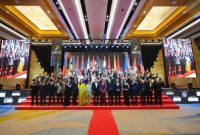CHINA – Media OutReach – 20 December 2019 – To be a leader requires many skills, including the ability to read and assess the emotional reactions of subordinates quickly and accurately. This skill, also known as emotional aperture, is an important leadership skill that allows leaders to interpret group reactions of organizational events.
“Emotional aperture ability provides a leader with a wealth of information about how a group is responding emotionally to a situation, and allows her to behave appropriately and strategically,” says Prof. Ying-yi Hong, Choh-Ming Li Professor of Marketing of Department of Marketing at The Chinese University of Hong Kong (CUHK) Business School.
In her recent research study in collaboration with researchers at Australian Catholic University in New South Wales and the University of Michigan Ross School of Business, Prof. Hong explores how culture affects emotional aperture.
“Accurately reading collective emotions is particularly necessary as individuals are regularly more dependent on accurate inferences regarding the collective’s beliefs, goals, and action tendencies, to harmoniously navigate social life,” she says.
Prior research have shown how, given the wide-ranging influence of collective affect, an individual’s ability to decode the collective affect can facilitate their success in liaising, leading, and navigating group dynamics. In a previous study, she and other researchers found that Chinese had lower level of collective empathy toward the 2011 Japanese Earthquake and Tsunami as compared with Americans.
However, it is not easy to interpret collective emotional reactions.
“Unlike perceiving individual emotions, where attention rests on a single focal target, perceiving collective emotions requires focusing on a broader view of targets. Given the inherent subtle, variant, and fleeting nature of emotional cues, the task of understanding the overall affective composition of a group can be challenging,” Prof. Hong says.
Global versus Local Processing
Human beings process information on either the holistic view of the specific information (global) or details of that information (local). Previous research studies have shown that people with high global processing ability are more successful at recognising collective emotions. Given its interdependent culture, Easterners are known to be more affected by the emotions displayed by the surrounding people than Westerners. In other words, Easterners’ global processing is more prevalent than their Western counterparts. However, does it mean that Easterners are really better at recognising collective emotions than Westerners?
To find the answer, Prof. Hong and her collaborators tested two hypotheses in the study: First, Chinese will show a higher level of accuracy in recognising patterns of group emotional reactions than will North Americans. Second, the cross-cultural variability predicted in the first hypothesis will be mediated by greater global processing exhibited among Chinese compared with North Americans.
A total of 98 American Caucasian undergraduate students from an American university and 79 Chinese undergraduates who were born in mainland China from a Hong Kong university were recruited for the study. The participants were told to report the emotional reactions that they saw in four-person group photos, whereby some of the persons in the photos show happiness, anger, fear or a neutral facial expression. The four-person group photos were shown very quickly (500 mini-second) so that it was not an easy task. On the other hand, the participants’ global versus local cognition was tested using the Navon letter identification task in which some large letters (e.g., “F”) were made up by some small letters (e.g., many “T”s). The participants were asked to identify either the large or small letter as quickly and accurately as possible. Quickly recognising the large letters requires a global processing of the whole image, whereas quickly recognising small letters requires a local processing of the details in the image. Therefore, the shorter reaction time in identifying the large letters in comparison to the small letters, the more global than local cognitive-oriented a person would be.
Cultural Differences in Recognising Collective Emotion
As predicted, the study showed that the Chinese participants demonstrated a higher level of accuracy in recognising group emotions than their American counterparts. However, the Chinese participants showed a lower level of accuracy in identifying individual emotions than did the North Americans. In addition, based on their responses in the Navon task, the Chinese participants were more global cognitive-oriented than their Western counterparts.
To further explore whether global cognition plays a role in collective emotion recognition, the researchers simulated 5,000 samples from the original data and attained a 95% confidence interval, suggesting that the indirect effect of global cognition on collective emotion recognition was significant. In other words, the Chinese students’ higher performance in recognising collective emotions was in fact influenced by their higher level of global processing.
“Growing up where the emphasis is on attending to the forest rather than the tree, it appears to shape fundamental ways individuals see emotional reactions,” says Prof. Hong. “Our results shows that among individuals from cultural contexts known to foster interdependence as compared with independence, there exists a greater ability to recognise subtle shifts in the emotional reactions of the collective.”
Future Study
Going forward, Prof. Hong says more research on how culture interplay with psychological processes are needed in order for human beings to have a more comprehensive understanding of how we make sense of our world.
“This research represents the first and initial exploration at examining evidence for cross-cultural variability in decoding collective emotions. As such, it opens a new line of investigation within the budding literature on collective emotion recognition and complements the traditional focus on individual emotion recognition processes,” says Prof. Hong.
“Moreover, based on our findings on reading collective affect, we expect that other domains of people perception, such as group hierarchy, group diversity and group competence, also operate differently across different cultures,” she says, adding that future studies will be worthwhile.


















